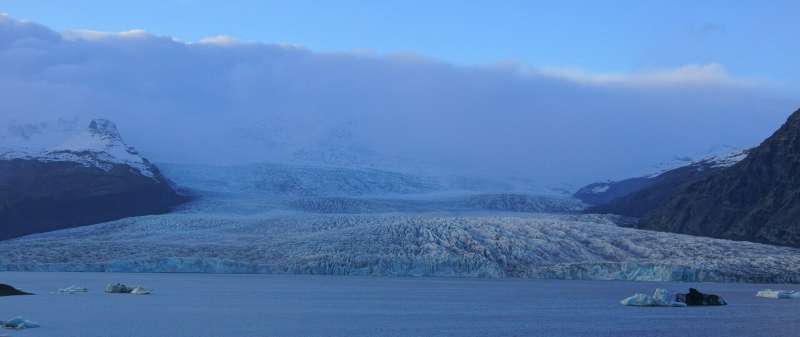Fiber optic sensing detects tremor from Icelandic subglacial volcano

Researchers used a fiber optic cable on the ice cap of an Icelandic subglacial volcano to detect low-frequency volcanic tremor, suggesting this technology could be useful in monitoring other ice-covered volcano systems.
Their research published in The Seismic Record indicates that the floating ice cap, part of the Vatnajökull glacier, acted as a natural amplifier of the tremor signals generated by the Grímsvötn volcano, one of Iceland's most hazardous.
This appears to be the first observation of a floating ice sheet acting as an amplifier of tremor, said Andreas Fichtner, a professor of seismology and wave physics at ETH Zürich. "Oscillations of ice shelves in Antarctica or Greenland have been known for a long time," he explained, "but they are mostly excited by ocean waves."
Although the exact mechanisms behind volcanic tremor can differ, it can be an indicator of deep volcanic or geothermal activity, Fichter said. "In addition to providing information about the underlying processes, tremor may also serve as a precursor of volcanic eruptions that should be monitored closely."
Grímsvötn is one of Iceland's largest and most active volcanoes, with major eruptions taking place on average every ten years. Geothermal heating melts the ice cap, creating a subglacial lake on the volcano that occasionally bursts forth and floods the coastal plains. Its explosive eruptions create towering ash plumes that affect agriculture, human health and aviation. Ash from the last major eruption in May 2011 closed Iceland's main airport and led to the cancelation of 900 flights.
Researchers would like to learn more about the seismic environment of Grímsvötn, but installing a traditional seismic network is expensive and difficult in the remote and harsh conditions at the subglacial volcano. Instead, Fichtner and colleagues turned to Distributed Acoustic Sensing.
Distributed Acoustic Sensing, or DAS, uses the tiny internal flaws in a long optical fiber as thousands of seismic sensors. An instrument called an interrogator at one end of the fiber sends laser pulses down the cable that are reflected off the fiber flaws and bounced back to the instrument. When the fiber is disturbed by seismic activity, researchers can examine changes in the timing of the reflected pulses to learn more about the resulting seismic waves.
The researchers deployed a 12.5 kilometer-long fiber-optic cable on Grímsvötn in May 2021 and collected data from the DAS system for three weeks.
"We wanted to know if a large DAS experiment in such a challenging and remote environment would actually be feasible at all and if it might teach us something new," said Fichtner. "Now, having analyzed the data in detail, we know that the discoveries we made would not have been possible with conventional stations. This includes not only the tremor-related ice sheet oscillations but also the nearly 3000 local earthquakes that we detected within the three weeks of the experiment."
After analyzing the densely sampled DAS data, the researchers realized that the floating ice sheet was acting as a natural resonator of seismic signals, allowing them to detect the volcanic tremor that might have otherwise been overwhelmed by other ambient or instrument "noise" in a traditional seismic network.
The research team got lucky with unusually nice weather—along with research huts equipped with a geothermally heated sauna on the highest point of the Grimsvötn caldera—during the fiber optic deployment. A trenching sled developed by researchers at the Icelandic Meteorological Office, which plowed and placed the cable at the same time, also helped.
"The real challenge was splicing in the field," Fichtner recalled. "Since we had three cable drums with four kilometers of cable on each of them, we had to connect the fibers, which is called splicing. An optical fiber is thinner than a human hair, and therefore it is difficult to handle on a glacier."
More information: Andreas Fichtner et al, Fiber-Optic Observation of Volcanic Tremor through Floating Ice Sheet Resonance, The Seismic Record (2022). DOI: 10.1785/0320220010
Provided by Seismological Society of America




















